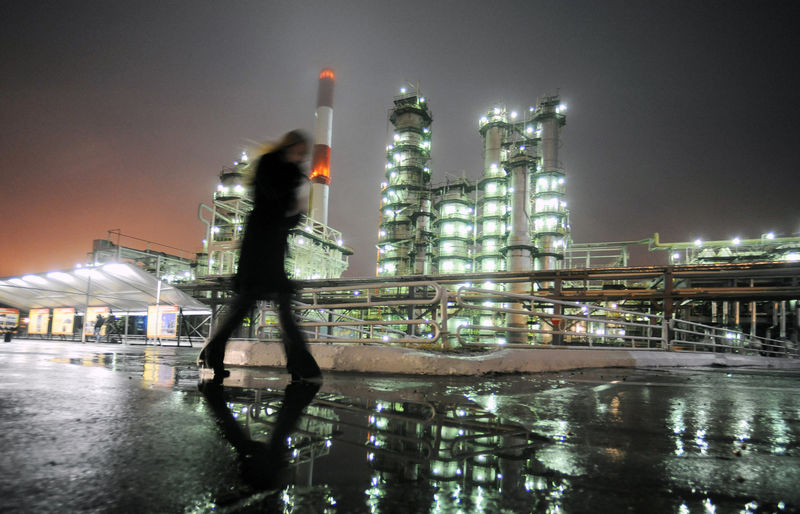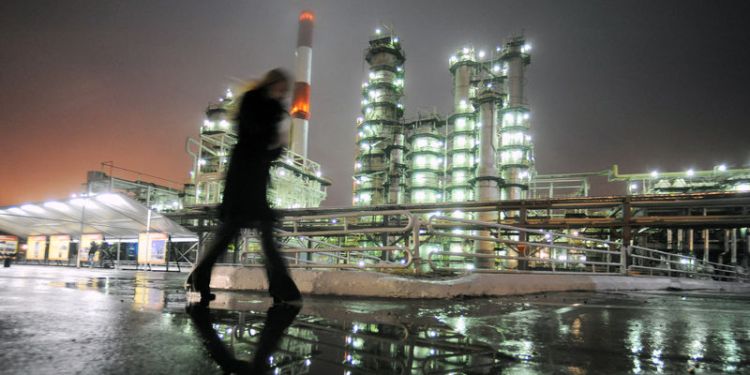
© Reuters. U.S. Oil Production to Cushion Price Hit to Economy, Eventually
(Bloomberg) — Any increased capital spending by U.S. oil and gas producers in response to the surge in crude price should help soften the blow to the economy from an expected pullback in consumer spending. It just won’t be anytime soon.
Americans in the last week have witnessed an unprecedented weekly surge in gasoline prices, now up to $4.17 a gallon based on American Automobile Association data. Prices are likely to go up even more as President Joe Biden details plans to ban imports of Russian energy.
Economists at Credit Suisse (SIX:CSGN) Group AG and Barclays (LON:BARC) Plc say that’ll incentivize greater domestic production, which should help alleviate some of the economic fallout.
“We do believe that higher oil prices will lead to increased domestic energy production which could help offset higher oil prices or any potential U.S. embargo on imports of oil from Russia,” said Michael Gapen, managing director and head of economic research at Barclays.
At the same time, “increases in domestic oil production are likely to take time and most producers are exercising greater capital discipline than before. It may take six to nine months to see a more meaningful increase in U.S. shale output,” Gapen said.
Before the start of war in Ukraine, producers were gradually adding to rig counts amid shareholder demands of capital discipline and government policy geared toward green energy. Moreover, supply and labor constraints have also been headwinds to a faster pace of production.
Production may ramp up in response to higher prices, according to Credit Suisse. While investment in energy makes up a smaller share of gross domestic product than consumer spending, which accounts for about two thirds, investment “already had significant upside even before the current shock,” economists Jeremy Schwartz, Xiao Cui and Justin Guo said in a note.
A sustained 1% contraction in global oil supply boosts prices by about 8%, representing a $15 billion hit for U.S. consumers, JPMorgan Chase & Co. (NYSE:JPM) economist Peter McCrory said in a March 4 note. As a result, the firm lowered its estimate of gross domestic product by 0.25 percentage point annualized in each of the first two quarters of the year.
“Overall, we see higher oil prices as posing a modest drag on GDP growth, which we still expect to be above-trend this year,” McCrory said in an interview.
Barclays economists said in a March 3 note that consumption growth could be about 0.5 percentage point lower by the fourth quarter as consumers generally absorb higher fuel prices by cutting back spending in other areas.
Still, since the U.S. exports just about as much petroleum as it imports, and given the enhanced development of U.S. shale production, the country has the ability to ramp up its own production, the economists said. That’ll help offset the drag on reduced household spending, they said.
“The U.S. economy has become much more resilient to changes in oil prices versus decades past; the share of gasoline in U.S. household spending remains near all-time lows and the revolution in shale has changed persistent net petroleum deficits to small net surpluses in recent years,” Barclays economists said in the note.
While boosting domestic production would bolster energy security for the U.S. and its allies, it’s not without challenges. For one, exploration and production firms have been trying to hold the line on expenditures and return more cash to shareholders. Second, supply and labor constraints may be standing in the way of a big production push.
The Permian Basin is suffering from labor shortages, according to Occidental Petroleum Corp (NYSE:OXY). Chief Executive Officer Vicki Hollub. Companies also don’t have enough rigs to support strong growth, and they’ve already used up most of the drilled-but-uncompleted wells that provided a quick uplift in growth in previous up cycles.
“The call for increased production from the U.S. at this point, especially with supply-chain challenges, can’t happen at the level that’s needed,” Hollub said Tuesday during CERAWeek by S&P Global (NYSE:SPGI), one of the energy industry’s biggest annual gatherings.
What Bloomberg Economics Says…
“The Biden administration has a powerful tool that could both maximize the cost to Russia for invading Ukraine and lower domestic inflation, and it’s not sanctions. We estimate that increasing U.S. shale production could replace U.S. oil imports from Russia, and even a substantial share of Russia’s exports to Europe.”
— Anna Wong, economist
Click here to read the full note.
Also, a larger push toward domestic oil production runs contrary to the Biden administration’s efforts to shift away from fossil fuels. Toby Rice, chief executive officer at shale driller EQT Corp (NYSE:EQT). said Monday on Bloomberg Television that there has been no direct dialogue between the White House and U.S. producers.
“It’s now time to build those channels of communication, and it has to come from the government reaching out in a non-confrontational way,” energy historian Daniel Yergin said in a Bloomberg TV interview Monday at CERAWeek.
Read more: Biden Is Banning Russian Oil. These Producers Could Fill the Gap
“Energy security fell off the table in the U.S. as we became self-sufficient in energy, and in fact it was like amnesia,” Yergin said. “It was not only taken for granted; it’s just forgotten.”
©2022 Bloomberg L.P.
Source: Investing.com



























